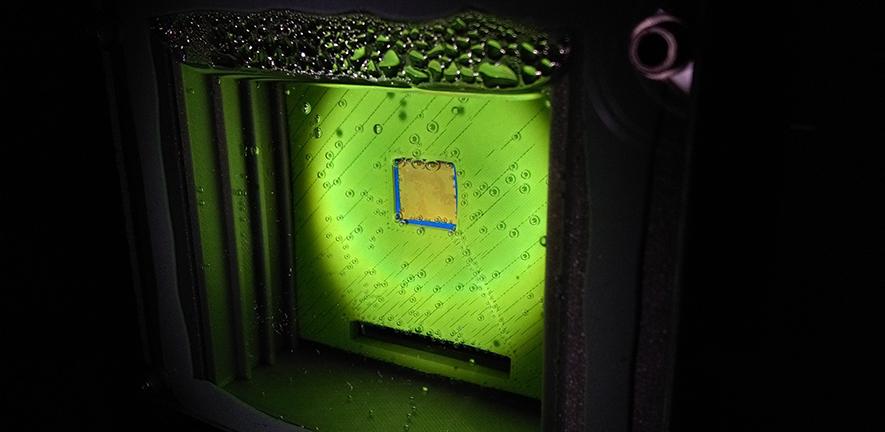2019/10/21 英国・ケンブリッジ大学

・ ケンブリッジ大学が、カーボンニュートラルな「人工葉」デバイスを利用した、サステナブルでシンプルな方法による合成ガス(syngas)の生成を実証。
・ 同「人工葉」デバイスは、太陽光を利用し、雨や曇りの日でも効率良く作動する。また、現在の合成ガス生成の工業プロセスとは異なり、環境中に二酸化炭素を放出しない。
・ 合成ガスは水素と CO から合成され、燃料、医薬品、プラスチックや肥料等の様々な製品の製造に使用されている。
・ 同デバイスは、植物が備える太陽光を吸収する分子のような、ペロブスカイト製の 2 個の光吸収体と、賦存量の豊富な元素のコバルトの触媒を組み合わせたもの。 同デバイスを水に浸すと、一方の光吸収体が触媒により酸素を生成し、もう一方の光吸収体が CO2 と水を CO と水素に還元して合成ガスを生成。
・ これらのペロブスカイト光吸収体は、雨天や曇りの日の少ない太陽光エネルギーでも機能するため、時間帯や季節を問わず使用可能。
・ 他で開発されている人工葉デバイスが生成するのは、通常水素のみ。今回の持続的な合成ガス生成の成功は、使用した材料と触媒の組み合わせに起因すると考える。
・ ペロブスカイト光吸収体は、シリコンや色素増感材料製のそれよりも、CO2 を CO に還元する反応に必要な高い光電圧と電流を供給。また、分子触媒に使用したコバルトは低コストであり、他の触媒に比して CO の生成に優れる。
・ 同大学では、本技術により、石油を代替する液体燃料を生成する方法を模索中。合成ガス生成後、液体燃料に変換する代わりに、CO2 と水からワンステップで液体燃料を生成したいと考える。
・ 風力や太陽光等の再生エネルギー源による発電技術は著しく発展しているが、世界の総エネルギー需要で電力が賄えているのは約 25%のみであることを考慮すると、合成ガソリンの開発が不可欠と考える。重量物輸送や航空等に持続可能なエネルギーを供給する液体燃料が求められている。
・ 同大学は、燃料としてすぐに利用できるエタノール等を製造する、持続可能な技術の開発を目指す。太陽光エネルギーと CO2 の還元反応でのワンステップ製造は困難だが、目指す方向と選択した触媒は適切であるため、近い将来に人工葉プロセスを実証できるデバイスの製造が可能と考える。
・ オーストリア政府とオーストリアの石油化学企業 OMV が本研究に共同出資。また、Winton Programme for the Physics of Sustainability 、Biotechnology and Biological Sciences Research Council(BBSRC) および英国工学・物理科学研究会議(EPSRC)より資金を得た。
URL: https://www.cam.ac.uk/research/news/artificial-leaf-successfully-produces-clean-gas
(関連情報)
Nature Materials 掲載論文(アブストラクトのみ:全文は有料)
Bias-free solar syngas production by integrating a molecular cobalt catalyst with perovskite–BiVO4 tandems
URL: https://www.nature.com/articles/s41563-019-0501-6
<NEDO海外技術情報より>
Abstract
The photoelectrochemical (PEC) production of syngas from water and CO2 represents an attractive technology towards a circular carbon economy. However, the high overpotential, low selectivity and cost of commonly employed catalysts pose challenges for this sustainable energy-conversion process. Here we demonstrate highly tunable PEC syngas production by integrating a cobalt porphyrin catalyst immobilized on carbon nanotubes with triple-cation mixed halide perovskite and BiVO4 photoabsorbers. Empirical data analysis is used to clarify the optimal electrode selectivity at low catalyst loadings. The perovskite photocathodes maintain selective aqueous CO2 reduction for one day at light intensities as low as 0.1 sun, which provides pathways to maximize daylight utilization by operating even under low solar irradiance. Under 1 sun irradiation, the perovskite–BiVO4 PEC tandems sustain bias-free syngas production coupled to water oxidation for three days. The devices present solar-to-H2 and solar-to-CO conversion efficiencies of 0.06 and 0.02%, respectively, and are able to operate as standalone artificial leaves in neutral pH solution.



